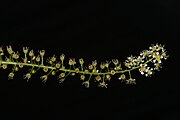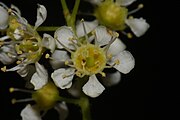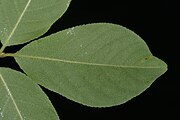Prunus alabamensis
| Prunus alabamensis | |
|---|---|

| |
| Scientific classification | |
| Kingdom: | Plantae |
| Clade: | Tracheophytes |
| Clade: | Angiosperms |
| Clade: | Eudicots |
| Clade: | Rosids |
| Order: | Rosales |
| Family: | Rosaceae |
| Genus: | Prunus |
| Subgenus: | Prunus subg. Padus |
| Species: | P. alabamensis
|
| Binomial name | |
| Prunus alabamensis | |
| Synonyms[2] | |
| |
Prunus alabamensis, the Alabama cherry[3] or Alabama black cherry,[4] is an uncommon to rare species of tree in the rose family endemic to parts of the Southeastern United States.[5] It is closely related to and found wholly within the range of Prunus serotina,[6] the black cherry, a more common and widespread species of Prunus also native to the region. Alabama cherry is sometimes considered to be a variety of Prunus serotina (i.e. Prunus serotina var. alabamensis), however most authors treat it as a distinct species.[6]
Description
[edit]Alabama cherry is a deciduous[4] flowering plant in the rose family endemic to the Southeastern United States. It is similar to but distinct in morphology from the closely related Prunus serotina.[6]
Form
[edit]Alabama cherry is a small or medium sized tree growing to heights of 20–40 feet (6.1–12.2 m)[4] and a diameter of about 6 inches (15 cm), scarcely exceeding 25–30 feet (7.6–9.1 m) in height.[7]
Bark
[edit]The immature bark is gray and smooth; mature bark is rough and becomes broken into plates that are dark-gray to black in color. Young shoots or twigs are green and pubescent,[4][7] often densely so, with rusty-brown hairs.[8]
Leaves
[edit]Leaves are alternate; ovate to elliptic in shape; rounded or slightly narrowed at the base; usually obtuse, rounded, or emarginate at the apex, but sometimes short acuminate, abruptly acute, or acutish; 3–12.5 centimetres (1.2–4.9 in) in length and 2–6.5 centimetres (0.79–2.56 in) in width; with petioles that are 2–12 millimetres (0.079–0.472 in) long. The margins are bluntly serrated with appressed teeth that have glandular tips. The upper surface of the leaf is dark green and the lower surface is a lighter green. The lower surface is uniformly but sparsely pubescent with rusty-colored hairs that are longer and more dense along the midrib but not conspicuous; axils of veins lack tufts of hair entirely; veinlets are prominent. The texture of leaves is leathery. In autumn, leaves turn a red or orange color.[4][7][8][9]
Flowers
[edit]Flowers grow from the axils of leaves on elongated racemes that are 4–6 inches (10–15 cm) long. Flowers have 5 small, white petals, and the rachis, peduncle, and calyx are pubescent.[4][7] Flowering occurs from April to May.[8]
Fruit
[edit]The fruit is a small reddish, dark purple, or black, globose drupe, about 10 millimetres (0.39 in) in diameter.[4][7][10] Fruiting occurs from June to August.[8]
-
Inflorescence
-
Flower
-
Lower surface of leaf
-
Upper surface of leaf
-
Immature bark with lenticels
Habitat and range
[edit]Alabama cherry is rare to uncommon in its range.[5][6][10] It grows in mixed oak-pine-hickory forests in sandy or rocky dry woodlands, on rocky slopes and sandhills, and on the summits of low mountains,[10] often associated with longleaf pine (Pinus palustris). It grows at elevations of 20–700 metres (66–2,297 ft).[4][8] It is known to occur in the states of Alabama, Florida, Georgia, Mississippi, and South Carolina,[3][4][11]
Classification
[edit]Relation to Prunus serotina
[edit]Alabama cherry is sympatric with its close relative Prunus serotina sensu stricto, occurring wholly within its natural range and being similar but morphologically distinct from it. They are easily distinguished from each other by the differences of their leaves and inflorescences.[6][7] Alabama cherry is sometimes considered to be conspecific with P. serotina; that is, a variety or subspecies rather than its own species. For example, as of 2023, Plants of the World Online[12] and Flora of North America[8] classify it as P. serotina var. alabamensis, but local botanical authorities and most authors classify Alabama cherry as its own distinct species,[6] including Auburn University,[13] the Alabama Herbarium Consortium and University of West Alabama,[4] and Weakley's Flora of the Southeastern United States.[14] The Global Biodiversity Information Facility also lists Prunus alabamensis as being the accepted name.[15]
Phylogenetic analyses have been done on Alabama cherry to determine if it is a genetically distinct species. A 2013 analysis found no clear genetic distinction between P. serotina var. serotina from Alabama and P. alabamensis,[6][16] however a following study in 2017 determined that P. alabamensis and P. serotina are indeed modestly genetically differentiated and either frequently exchange genes with each other or do not exchange genes and have only recently diverged. The study also suggested that future research should investigate what underlying factors are maintaining the phenotypic distinctiveness between the two.[6]
Edibility and toxicity
[edit]The fruit and seed are edible and can be eaten raw or cooked, however caution should be taken when consuming the seed as this plant belongs to a genus where most or all species produce the volatile toxin hydrogen cyanide, mostly in their leaves and seeds. Levels are usually too small to do any harm, but especially bitter fruits or seeds should not be eaten.[10]
Other uses
[edit]Green dyes can be obtained from the leaves and fruits.[10]
References
[edit]- ^ "Prunus alabamensis | NatureServe Explorer". explorer.natureserve.org. Retrieved 2023-05-26.
- ^ Tropicos, Prunus alabamensis C. Mohr
- ^ a b USDA, NRCS (n.d.). "Prunus alabamensis". The PLANTS Database (plants.usda.gov). Greensboro, North Carolina: National Plant Data Team. Retrieved 14 October 2015.
- ^ a b c d e f g h i j Alabama Plant Atlas, Prunus alabamensis C. Mohr, Alabama Black Cherry
- ^ a b "Flora of the Southeastern United States | Prunus alabamensis". fsus.ncbg.unc.edu. 2023-07-14. Archived from the original on 2023-07-14. Retrieved 2023-07-14.
- ^ a b c d e f g h Konrade, Lauren Ashley. "Evaluating range genetics in black cherry (Prunus serotina) and the genetic status of an enigmatic relative, Alabama cherry (Prunus alabamensis) | Chapter 2: Is the rare Alabama cherry (Prunus alabamensis) genetically distinct?" (PDF). pp. 13–22. Archived (PDF) from the original on 2023-05-28.
- ^ a b c d e f Mohr, Charles (March 1899). "Notes on Some New and Little Known Plants of the Alabama Flora". Bulletin of the Torrey Botanical Club. 26 (3): 118–121. doi:10.2307/2477818. hdl:2027/hvd.32044106352883. JSTOR 2477818.
- ^ a b c d e f "Prunus serotina var. alabamensis - FNA". floranorthamerica.org. Retrieved 2023-05-28.
- ^ "Key to Prunus, Key A: BLACK-CHERRIES, subgenus Padus - FSUS". fsus.ncbg.unc.edu. Retrieved 2023-08-06.
- ^ a b c d e "Prunus alabamensis Alabama Cherry PFAF Plant Database". pfaf.org. Retrieved 2023-05-26.
- ^ Biota of North America Program 2014 county distribution map for Prunus alabamensis
- ^ "Prunus serotina var. alabamensis (C.Mohr) Little | Plants of the World Online | Kew Science". Plants of the World Online. Retrieved 2023-05-28.
- ^ "Auburn.edu Plant Database | Alabama Cherry". ssl.acesag.auburn.edu. Retrieved 2023-05-28.
- ^ "Prunus alabamensis (Alabama Black Cherry) - FSUS". fsus.ncbg.unc.edu. Retrieved 2024-09-24.
- ^ "Prunus alabamensis C.Mohr". www.gbif.org. Retrieved 2023-05-28.
- ^ Liu, Xiao-Lin; Wen, Jun; Nie, Ze-Long; Johnson, Gabriel; Liang, Zong-Suo; Chang, Zhao-Yang (2012-12-14). "Polyphyly of the Padus group of Prunus (Rosaceae) and the evolution of biogeographic disjunctions between eastern Asia and eastern North America". Journal of Plant Research. 126 (3): 351–361. doi:10.1007/s10265-012-0535-1. ISSN 0918-9440. PMID 23239308. S2CID 254169519.






